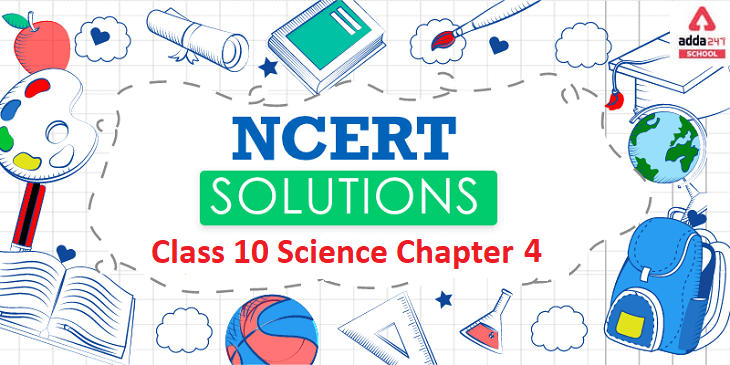Table of Contents
Class 10 Science NCERT Solutions for Chapter 4: Carbon and its Compounds
Adda247 provides NCERT Solutions for class 10 Science. The NCERT Solutions provided here will enhance the concepts of the students, as well as suggest alternative methods to solve particular problems to the teachers.
Chemistry is much more than the language of Science. We aim to aid the students with answering the questions correctly using logical approach and methodology. The NCERT Solutions provide ample material to enable students to form a good base with the fundamentals of the subject.
Class 10 board examination is the most crucial exam in every students’ life. Their future studies and career depend on the mark secured in the board exams. Every student works hard to score well in class 10 CBSE examinations. Science among all the subjects of class 10 has a vital role in every student’s career. Science teaches us how the world and our environment is made. The students can secure better marks in the science subject if they want to become a doctor or an engineer in future. It is important that they should prepare and study hard for this subject so they don’t lose marks.
For the students in Class 10 Science is a great book to refer to. The Class 10 Science Solutions are available chapter-wise at Adda247 and can prove to be very useful for the students. Whether you are struggling to grasp the concepts of various topics in the chapters or willing to push yourself to score better in the exams, NCERT Solutions for Class 10 Science PDF is the answer for you. These solutions are provided in an easy-to-understand language and will promote self-learning among students. The CBSE Class 10 Science Solutions, available for all the chapters, encourage a spirit of learning among students. Can learn all the chapters by following the NCERT Science Class 10 Solutions without even having to step out of their homes.
Read: NCERT Solutions Class 10 Science Chapter 1
Read: NCERT Solutions Class 10 Science Chapter 2
Read: NCERT Solutions Class 10 Science Chapter 3
Read: NCERT Solutions Class 10 Science Chapter 4
NCERT Solutions for Class 10 Science Chapter 4 PDF Download
Adda247 provides the downloadable PDF of NCERT Solutions for Class 10 Science absolutely free of cost. All you need to do is register on the site and download the file. At Adda247, these solutions are designed by subject matter experts who have immense knowledge and experience. These are designed as per the latest NCERT guidelines and exam pattern to make it a reliable material for exam preparation.
While solving the textbook questions, students often find doubts and get confused. The NCERT Solutions for Class 10 come in handy at such times, as they include precise explanations and detailed answers to those questions. These CBSE Class 10 Science NCERT Solutions cover solutions to all the important chapters included in the textbook-like Matter, Atom, tissues, Living Organisms, Motion, Force, Law of Motion, Gravitation, Energy and work, Sound, Natural Resources, etc.
Along with answers to the textbook questions, these solutions provide you extra questions, exemplar problems, their solutions as well as tips and tricks.
Benefits of NCERT Solutions Science Class 10 Chapter 4
The benefits of Class 10 Science solutions are endless and will clear doubts for every candidate, as all prospective questions on these topics are answered here.
- NCERT Solutions for Class 10th Science provides a clear insight into combustion and flame.
- The solutions are given into simple language and can be understood by all students.
- The solutions are given by experts.
- All the topics that can appear in the exams are covered thoroughly in these solutions for the students to gain more marks in the examination.
Class 10 Science Ncert Solutions Chapter 4. Carbon and its Compounds Important Topics
Carbon compounds are defined as chemical substances containing carbon. More compounds of carbon exist than any other chemical element except for hydrogen. … In general bonds of carbon with other elements are covalent bonds. Carbon is tetravalent but carbon free radicals and carbenes occur as short-lived intermediates.
Their varied properties are only because of the different arrangement of the carbon atoms. In fact, the entire field of organic chemistry is based on carbon and the bonds it forms. The study of chemistry carbon and its compounds is undoubtedly essential for understanding the elements available around us.
The four major categories of organic compounds that are present in all living things are carbohydrates, lipids, proteins and nucleic acid.
Some of the most important compounds of carbon are carbon dioxide (CO2), carbon monoxide (CO), carbon disulfide (CS2), chloroform (CHCl3), carbon tetrachloride (CCl4), methane (CH4), ethylene (C2H4), acetylene (C2H2), benzene (C6H6), acetic acid (CH3COOH), and their derivatives.
Carbon is basis for all living organisms and a versatile element. It is tetravalent and has the property of catenation. Carbon forms covalent bonds with oxygen, chlorine, hydrogen, nitrogen sulphur and itself. It can form double and triple bond compounds. There exits three types of carbon chains. Carbon is considered as a major source of fuel.
NCERT Solutions Class 10 Science Chapter 4 Important Questions
NCERT Solutions for Class 10 Science Chapter 4 – Carbon and its Compounds helps students to understand concepts provided in the textbook in detail. NCERT Solutions for Class 10 Science, provides solutions to all the questions asked at the end of every chapter as well as the questions printed with a chapter.
Question : How many covalent bonds are in C2H5?
- 6 covalent bonds .
- 8 covalent bonds.
- 7 Covalent bonds.
- 5 covalent bonds.
Answer :
( c.) 7 covalent bonds.
Question : What is the functional group in the Butanone?
- Ketone
- Aldehyde
- Ether
- Alcohol
Answer :
- ) Ketone.
Question : When the bottom of the vessel is getting blackened on the outside while cooking, it shows that
- The food is cooked completely.
- The fuel is not burning completely.
- The food is not cooked.
- The fuel is burning completely.
Answer :
- ) The bottom of the vessel is getting blackened on the outside, then it means that the fuel is not burnt completely.
Question : Explain the nature of the challenge bond using the bond formation in CH3Cl.
Answer :
Carbon is tetravalent in nature. In the outermost she’ll, carbon have four electrons removal of these electrons needs more energy and gain the four electrons needs more energy. To complete the octet, carbon needs to share the four electrons with other carbon atoms or different atoms. Carbon forms one bond with chlorine and three bonds with hydrogen.
Question : What is homologous series? Explain with an example.
Answer :
A homologous series is a series of carbon compounds that have some chemical properties but different physical properties and the differences between two successive compounds is -CH2.
For example : Alkanes family. The general formula of Alkane is CnH2n+2.
Methane CH4
Ethane C2H6
Propane CH3CH2CH3
Butane CH3CH2CH2CH3
Question : How can ethanol and ethanoic acid be differentiated on the basis of their physical and chemical properties?
Answer:
Chemical properties :
Ethanol is alcohol and ethanoic acid is carboxylic acid. When alcohol and carboxylic acid reacts with carbonates and bicarbonate than only carboxylic acid reacts with carbonates and bicarbonates and evolve the CO2 gas that turns lime water milky.
Physical properties :
The melting point of ethanol is – 114.1 degree C and ethanoic acid is 16.6 degree C. Ethanoic acid melting point is below the room temperature it freezes during winters. Ethanol is liquid at room temperature but ethanoic acid is solid at room temperature Ethanol has pleasant smell and ethanoic acid is vinegar smell.
Question : In the electrolytic refining of a metal M, what would you take as the anode, the cathode and the electrolyte?
Answer:
In the electrolytic refining of a metal M:
Anode à Impure metal M
Cathode à Pure metal M.
Electrolyte à Solution of salt of the metal M.
Question : Why are carbon and it’s compound used as fuels for most applications?
Answer :
When the saturated carbon compounds burnt with air form a carbon dioxide, water with lot of energy and light. In this reaction no smoke will produce section less pollution. It is exothermic process. It is used as fuels because high calorific value.
Question : Explain the formation of scum when hard water is treated with soap.
Answer:
Soaps are the sodium or potassium salt of long chain of carboxylic acid. Hard water contains the chloride and sulphates of calcium and magnesium. When soap will add in the hard water form less lather so some amount of salt is unused. This insoluble salt is known as scum.
Question : What change will you test soap with litmus paper?
Answer :
Soap is basic in nature so red litmus turns blue but blue litmus remains same.
Question :12 What is hydrogenation? What is it’s industrial applications?
Answer :
The addition of hydrogen on the unsaturated compounds are known as hydrogenation. It is a addition reaction in the presence of Ni/Pt/Pd as catalyst. Unsaturated compounds convert into saturated compounds. Through this process the vegetable oil is converted into ghee.
Question : Which of the following hydrocarbons undergo addition reactions:
Answer:
Unsaturated hydrocarbons undergo addition reactions The unsaturated hydrocarbons general formula is CnH2n-2 or CnH2n.
I’m the given compounds C3H6 and C2H2 undergo addition reactions while C2H6, C2H8 and CH4 are saturated hydrocarbons.
Question : Give a test that can be used to differentiate chemically between butter and cooking oil.
Answer :
Cooking oil is unsaturated fats but butter is saturated. By hydrogenation, oil will reacts but butter will not reacts.
Question : Explain the mechanism of the cleaning action of soaps.
Answer :
Cleansing action of soaps:
Soap contains the two parts. One part is hydrophobic and the other is hydrophilic. Soaps are the sodium or potassium salt of long chain of carboxylic acid. When the dirty clothes dip in the soap solution, the hydrophobic ends attach the dirt and form a big cluster. This cluster is known as micelle and trap the dirt.
Que. What is the electron dot structure of carbon dioxide
Ans. Cross dot structure of CO2.
Que. How many structural isomers possible for permanent?
Ans.
Three structural isomers for pentane.
- CH3CH2CH2CH2CH3
- CH3CH(CH3)CH2CH3
Que. What are the two properties of carbon to form a large number of compounds?
Ans.
The two properties of carbon to form a large number of compounds are:
- Catenation – It is ability to form a bond with itself. It is the self linking ability
- Tetravalency – Carbon can make only four bonds. That arrangement of the atoms are known as tetravalency.
Que. Why is mixture of ethyne and air is not used?
Ans.
When ethyne is burnt in air, it gives a sooty flame due to unsaturation nature. If ethyne is burnt with oxygen, it gives a clear flame with temperature 2500 degree C because of complete combustion. Oxy-acetylene flame is used for welding. It is difficult to attain this much high temperature without mixing oxygen that’s why a mixture of ethyne and air is not used.
Que. Distinguish experimentally between an alcohol and carboxylic acid.
Ans.
When alcohol and carboxylic acid reacts with carbonates and bicarbonates and evolve the CO2 gas that turns lime water milky.
Que. What are oxidising agents?
Ans.
An oxidizing agent is a reactant that removes electrons from other reactants during a redox reaction For example: Alkaline potassium permanganate and acidified potassium dichromate.
The NCERT Solutions for Class 10 Science are genuine and can be referred by the students as guide to prepare for their CBSE Term II examination. The content provided is straightforward, which makes it easy to understand.
Key features of NCERT Solutions Class 10 Science Chapter 4
- These solutions will enables the students to have an overall idea of the topic.
- Every students prefers to revise all the chapters before any examination. These NCERT Solutions will help them to cover all the subtopics in minimal time.
- These NCERT Solutions will help students to understand and remember the concepts of large and confusing chapters.
- The downloaded version of NCERT Solutions for Class 10th Science allows the students to have access to it all time.
- The CBSE Class 10 Science solutions ensure high scores for all types of students.
- The NCERT Class 10 Science encourages students to perform several activities to understand the concepts better.
FAQs on NCERT Solutions of Class 10 Science Chapter 4
1 List out the topics present in the Chapter 4 of NCERT Solutions for Class 10 Science.
Ans. The topics present in Chapter 4 of NCERT Solutions are –
1 Bonding in Carbon – The covalent bond
2 versatile nature of carbon
3 Chemical properties of Carbon compounds
4 Some important carbon compounds – ethanol and ethanoic acid
5 Soaps and detergents
2 What types of questions are present in the Chapter 4 of NCERT Solutions for Class 10 Science?
Ans. The type of questions present in the chapter 4 of NCERT Solutions are-
1 Short answer – 2 questions
2 Long answer – 7 questions
3 Very long answer – 3 questions
3 What is the significance of carbon and its compounds?
Ans. Carbon is the most important element to life. Without this element, life as we know it would not exist. As you will see, carbon is the central element in compounds necessary for life-organic compounds. These compounds include carbohydrates, lipids, proteins and nucleic acids
The reason is carbon’s ability to form stable bonds with many elements, including itself. This property allows carbon to form a huge variety of very large and complex molecules. In fact, there are nearly 10 million carbon-based compounds in living things!
4 How can I Solve Class 10 Science Chapter 4?
Ans. You can solve Class 10 Science Chapter 4 by referring to the NCERT Solutions on Adda247. By referring to the NCERT Solutions PDF, you have step-by-step solutions to each question in a detailed but comprehensive language. If you practice the NCERT Solutions for Class 10 Science Chapter 4, you will be fully prepared to answer any question from that chapter.
5 How can I understand Class 10 Science Chapter4?
Ans. You can understand class 10 Science Chapter 4 Carbon and its compounds by referring to NCERT Solutions Class 10 Science Chapter 4 on Adda247. You can get the best explanations of the chapter including details on all important subtopics. The easy language will help you in grasping the concepts. All the exercises questions are also fully solved to give you a complete understanding of the chapter.



 Bihar Board 12th Result 2025 Out @ inter...
Bihar Board 12th Result 2025 Out @ inter...
 JEE Mains 2025 Session 2 Admit Card Out,...
JEE Mains 2025 Session 2 Admit Card Out,...
 Join ONE-Pro-Max - MAHAPACK for NEET-UG ...
Join ONE-Pro-Max - MAHAPACK for NEET-UG ...









